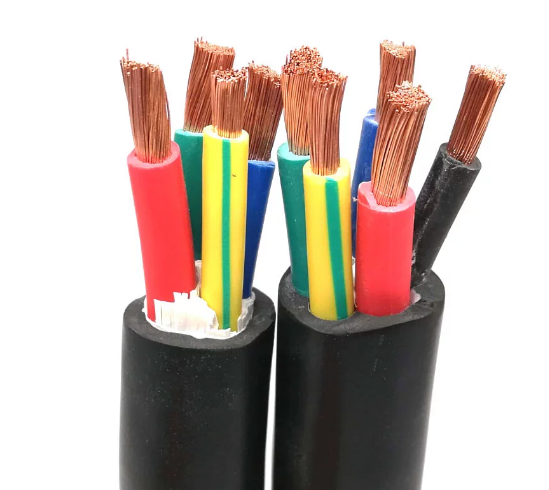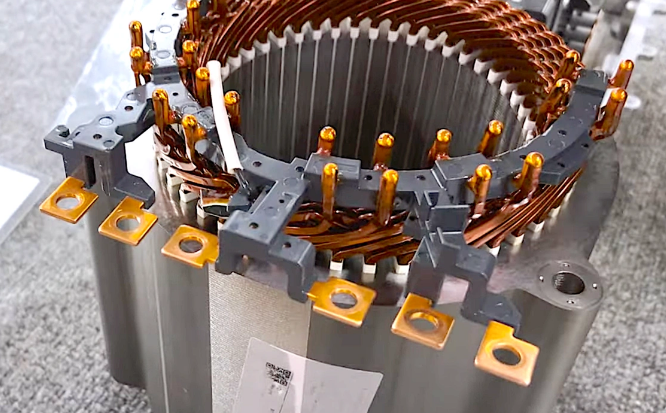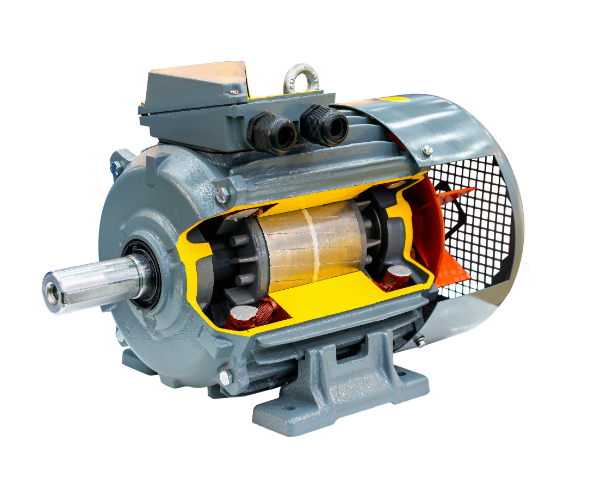These Tesla electric vehicles employ a three-phase AC motor—more specifically, permanent magnet synchronous motors. The three-phase drive drives the rotor with three phases of AC current out of phase by 120 degrees, hence higher efficiency and high output torque. In real life, Tesla’s motor can change power output in real time through advanced electronic control systems for optimized performance in various driving conditions. All this enables Tesla to optimize the requirements of quick acceleration response and energy management.
Motor Basics
Generally speaking, an electric motor is an important device that transmits electrical energy into mechanical energy. In this regard, it usually is categorized as direct current motors and alternating current motors. In relation to the above, AC motors can further be divided into single-phase and three-phase motors. Three-phase motors, however, are normally used in high-power applications owing to their prominent advantages regarding energy-conversion efficiency, torque output, and operation stability.
A three-phase motor works according to the features of three-phase AC. The latter is changed simultaneously in three conductors with a phase displacement of 120 degrees in each, thus creating a rotating magnetic field that drives the rotor of the motor. Three-phase motors have greater starting torque and a higher power factor compared to single-phase motors. The three-phase motors find wide applications in various types of industrial equipment and electric cars.
In an electric vehicle power system, a three-phase motor is preferred due to its high power density and efficiency. According to the IEEE, the efficiency of a three-phase motor can be more than 90%: only 10% of the energy is converted to heat during the energy conversion process. As such, single-phase motors can only realize an ideal condition efficiency of 70% to 85%, making them less suitable. Hence, in electric vehicles, where range and economy in energy use are a big factor, three-phase motors are normally used.
What is Three-Phase
The three-phase power consists of three independent alternating currents out of phase with one another by 120 degrees. It is a power system that tries to raise the efficiency and stability in operating machinery. The applications for three-phase power would range from power transmission systems, industrial machinery, and reaching to power systems of electric vehicles.
Three-phase systems work on the basis of complex circuit theories. In a three-phase system, the phases change in a sine wave form with a phase difference of 120 degrees between each phase. This design ensures that at any given time, one phase of current is at its peak, ensuring a stable power output. For three-phase power, under the same conditions, has greater transmission of power and therefore has major advantages in high-power applications, such as motor drives, generators, and transformers.
The advantages of three-phase power are not confined to power output. Because the current in three-phase power is constantly changing, three-phase motors are much more efficient and reduce energy losses considerably. Furthermore, three-phase motors ensure more stability while starting or stopping, which causes less impact on the electrical grid. All this is very important in great industrial machinery and electric cars.

Tesla Motor Design
The motor design in Tesla applies high-level PMSM technology, which integrates the advantages of three-phase motors. Permanent magnets further enhance the magnetic field in order to increase efficiency and power in motors. Tesla usually chooses a high-energy-density rare earth permanent material for designing large power output within a smaller volume in its motor design.
The power output, for instance, is exclusively available with the Tesla Model S, reaching up to 440 horsepower, while the torque can ensure instantaneous values as high as 600 Newton-meters. Such an efficient design does not only guarantee rapid acceleration but also provides much-needed stability during high-speed driving.
Of all the other technologies in Tesla’s motor design, the most important would have to be the cooling system. Because during long motor operations, a lot of heat is generated, and if this is poorly dissipated, it will reduce both motor performance and lifespan. Tesla does this with liquid cooling: it circulates coolant through the windings and stator channels within the motor for keeping the motor at high loads and temperatures.
Tesla motors also have sophisticated electronic control systems that monitor operating status and load conditions of the motor in real time and automatically regulate power output. The intelligent control technology enables the motor to maintain its optimum performance under different conditions of driving with advantages of improving driving experience and safety.
Efficiency Explained
Tesla motors are also supposed to be rated by their efficiency. Official data from Tesla shows that the efficiency of the motors could easily remain above 90% in general, for several different operating conditions, thereby ranking first in the electric vehicle industry. This means high-efficiency motors will waste less energy and provide a longer range to the vehicle.
Its high efficiency can be attributed to the design and operating principles of three-phase motors, whereby the continuity of the current allows the motor to maintain stable power output during load variation due to significant reduction in energy losses. Besides, the start-stop performance of three-phase motors is good. Thus, it may realize more economical energy consumption in the urban condition of frequent stops.
Taking Tesla Model 3 as an example, its motor achieves an energy efficiency of 15.3 km per kWh when the average for similar models was 14.5 km/kWh. Well, this might not be considered enough, but a minimum energy loss could make a difference in traveling long ranges, especially while driving on highways.
The other contributor that matters most for efficiency improvement is Tesla’s regenerative braking system. Every time the vehicle is slowing down or going downhill, its electric motor can go into generating mode, re-converting a portion of the kinetic energy back to electrical energy for storage in the battery. This increases energy utilization efficiency and prolongs service life for the battery.
Performance Insights
Tesla motors are also doing very well both on and off different terrains of driving. From populous city traffic to highway driving, Tesla motors can quickly respond to the demands of the driver by showing instant acceleration. This rapid responsiveness is due to the structural design of the motor and real-time adjustments by the electronic control system.
However, in reality, there’s great power performance coming from the Tesla Model X. For instance, when running at 100 kilometers per hour on highways, the motor delivers stable power supply for safe and comfortable driving. Fast torque response allows easy catching-up anytime.
Performances of Tesla motors are relatively steady in different climatic conditions. While extreme cold weather may eventually affect battery performance, the motors are very well capable of normal operation in those conditions. This is mainly because of Tesla’s optimization in motor and battery management systems. The battery management system in Tesla can preheat the battery at low-temperature environments to ensure quick response and efficiency at the time of starting a motor.

Advantages of Three-Phase
The advantages of three-phase motors are that their efficiency is good and the power output is high; thus, they are eminently suitable for applications requiring sustained high loads. Compared to single-phase motors, three-phase motors offer greatly improved starting torque, operational stability, and energy conversion efficiency.
Three-phase motors feature a starting torque of two to three times higher than for single-phase motors, thus allowing quicker and smoother vehicle startups. Besides, the three-phase motor operates on general efficiency ranging from 85% to 95%, hence minimizing waste of energy and other operational costs.
Tesla has managed to capture an enviable reputation in the electric vehicle market with three-phase motors. The acceleration performance and range capabilities are noticeably superior, allowing Tesla to stay atop its game in this highly competitive market.
The reason why three-phase motors are much better in performance is that their structure is reasonably designed to reduce energy loss effectively. In operation, the rotating magnetic field formed by the three-phase currents balances the load and avoids performance instability brought about by single-phase current fluctuations. Under such a design, three-phase motors can work stably under various working conditions and improve the whole vehicle’s safety and dependability.
Real-World Applications
Three-phase motors already have their applications in the electric vehicle sector quite common. Besides Tesla, many other brands of electric vehicles have started the application of three-phase motors. Be it passenger cars, commercial vehicles, or public transportation, with the advantages that three-phase motors possess, they become the standard for modern electric vehicles.
In actual practice, it not only supports powerful power but also integrates with intelligent electronic control systems for smarter driving. Most electric vehicles nowadays are equipped with advanced driving assistance systems that can only provide more accurate power regulation based on the effective performance of the motor to improve driving safety.
Tesla’s high-performance three-phase motors are required in autonomous driving. For instance, intelligent adjustment of motor output further optimizes the driving experience of a vehicle in real-time monitoring of status and environment. Under different road conditions, the high efficiency of the three-phase motor makes vehicles maintain a high range in an autonomous driving process.








